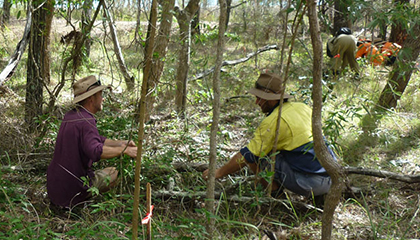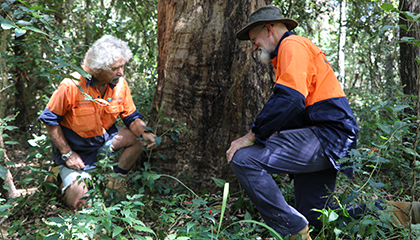Community Environment Program
Bushcare volunteers are currently needed to help maintain, protect and enhance our natural areas. Give bushcare a go – it might just grow on you!
Register to Volunteer
The Community Environment Program (CEP) provides opportunities for residents to actively participate in the maintenance and management of activities of bushland and open spaces, as well as environmental awareness programs, including events and education. The CEP aims to form long-lasting positive partnerships between Council, the community and special interest groups through a joint commitment to help maintain, protect and enhance the Fraser Coast’s reserve and open space network for present and future generations.
Volunteers should have a keen interest in caring for reserves and open spaces, enjoy working outdoors, want to learn about the environment and gain new skills, and enjoy working in teams. Volunteer opportunities depend on existing group size, level of experience and current projects.
Volunteers will have the opportunity to become involved in the following activities:
- Restoring natural areas including tree planting and weed management.
- Assessing the health of reserves and open spaces.
- Project planning, implementation and monitoring.
- Fauna and flora observations and recording.
- Participating in various events such as community tree planting days.
- Seed collection and propagation.
Groups
Currently, there are seven Community Environment Program groups across the Fraser Coast region including:
Fay Smith Wetlands Bushcare Group
The Fay Smith Bushcare Group has been operating since 2006 and has historically consisted of members from the Wildlife Preservation Society and Lower Mary Catchment Care Group.
Being surrounded by urban development the park is heavily infested with many species of weeds.
The primary focus of the group is on removing and controlling weeds which pose the biggest threat to the biodiversity of the reserve.
In limited areas, they have achieved the control of some of the most troublesome weeds, such as Blue Billy-goat Weed, Prickly Asparagus, Mother of Millions, Silver Leafed Desmodium and Mile a Minute.
Fay Smith Wetlands is located in Maryborough on the corner of Neptune and Victory Streets.
Friends of Arkarra
The Friends of Arkarra group was originally started in the early-mid 2000’s by local environmental pioneer, John Eggleston, who also began the Fraser Coast Community Nursery. John conducted many planting activities and received assistance from nearby residents.
The primary focus of this group is to maintain the biodiversity and natural integrity of the reserve through bush regeneration activities, primarily weed management. The Friends of Arkarra is one of Council’s smallest Community Environment Program groups and is looking for more members.
The group holds regular working bees within the Arkarra Lagoons Environmental Reserve on one Saturday each month.
Friends of Parraweena Park
For several years prior to 2014, the Friends of Parraweena Park assisted with the planting of native species and weed control within the Parraweena Park Bushland Reserve. The group ceased their activities for a few years; however, in 2018 they were revived under the auspices of Council’s Community Environment Program.
The primary focus of the group is to maintain the biodiversity and natural integrity of the reserve through bush regeneration activities, primarily weed management. The Friends of Parraweena Park is one of Council’s largest Community Environment Program groups, with approximately 30 members.
This group holds regular working bees within the reserve on one Sunday each month, excluding December and January.
Toogoom Foreshore Group
The Toogoom Foreshore project commenced in November 2005 and was one of the first Community Environment Program sites. Native indigenous species have been planted to promote revegetation following the removal of large areas of weeds. 
The aim of the project is to allow the foreshore to regenerate and become a self-sustaining environmental area. By removing all exotic weeds and giving space for indigenous species to revegetate, a natural bush corridor is once again taking shape. This also assists the beach dune to act in a more natural and self-managing way.
This group meets fortnightly on Thursday mornings for two hours. Hand removal of all exotic weeds is carried out. Native seeds are also spread to promote revegetation in barren areas. Weeds with seed heads are removed from site, but all other plant matter is bagged and used as mulch on site. Plantings are carried out, mainly to stabilise sand dunes, or to reintroduce lost or rare species.
The Toogoom foreshore has diverse vegetation – from dune to rainforest. It is home to a variety of wildlife including monitor lizards, bearded dragons, butcher birds and butterflies, with wildlife diversity increasing in revegetated areas. This increase in the presence of wildlife provides evidence that rehabilitation activities in this area are working, and the ecosystem is slowly re-establishing itself.
Botanic Gardens Bushcare Group
The Botanic Gardens Bushcare Group formed in 2019 when a small group of volunteers from the Fraser Coast Community Nursery began working in an adjacent area of the gardens, in an effort to reduce weed invasion into the Nursery. The group has since expanded and now meet once a month to work in a more defined area of bushland along the pathways near the Nursery.
The primary focus of the group is to protect and enhance the quality of the bushland areas of the Hervey Bay Botanic Gardens, principally through the management of key invasive weeds and the fostering of natural regeneration of locally native species.
Progress has been slow but steady, with increased natural regeneration of native species providing a key indicator of the impact the group has had in the short time they have been working in this area.
Fraser Coast Community Nursery
The Fraser Coast Community Nursery was initially set up when former Hervey Bay City Council began the Community Environment Program in early 2006. The Nursery was established to supply native plants for CEP and other Council revegetation projects at the time, including Land for Wildlife.
Experienced nursery manager and plant enthusiast, John Eggleston, trained and supervised a small group of volunteers in the many aspects of plant propagation and care. He remained as volunteer Nursery Team Leader until 2011. His dedication and major contribution cannot be understated, and the group would not have been able to establish itself and progress without him.
The first plants to be propagated were Vitex trifolia (Coastal vitex), Casuarina equisetifolia (Coastal She-oak) and Hibiscus tiliaceus (Cottonwood) for use along the foreshore.
The Nursery now propagates over 300 different local plant species which are used by Council and community groups for revegetation and reserve projects throughout the Fraser Coast region.
Volunteers are extremely important in the Nursery, helping with propagation and maintenance of the plants. There are regular opportunities to learn new skills, from caring for a garden, to identifying native fauna – birds, butterflies and garden insects – to learning about bush tucker and medicines, all in a friendly and welcoming environment.
Please note: all volunteer sessions in our Nursery are now FULL. We are not currently accepting volunteers in this area.
Click here to learn more
Citizen Science Group
The Citizen Science Group began conducting excursions in 2014, with group members regularly going out in the field to observe and identify plants. Members share a common interest in the science of native plants, although some are keen on other wildlife such as fungi, birds and butterflies.
The aim of this group is to learn more about the plants of the Fraser Coast region through observation, hands-on activities and research.
Group members are motivated to solve botanical mysteries, especially the location of unusual and rare native species.
This group explores Council-managed land throughout the Fraser Coast and meets several times a year.
Volunteer Schedule
| Group |
Day |
Time |
Frequency |
Physical Requirements |
| Arkarra |
Saturday |
7.30am - 9.30am |
1 x per month |
Moderate: hand weeding |
| Botanic Gardens Bush Care |
Thursday |
8am - 10am |
1 x per month |
Moderate: hand weeding |
| Fay Smith |
Monday |
6am-9pm |
|
Moderate: hand weeding |
| Wednesday |
6am - 9pm |
|
Moderate: hand weeding |
| Friday |
6am - 9pm |
|
Moderate: hand weeding |
Nursery
Please note: all volunteer sessions are now FULL.
We are not currently accepting new volunteers for the Nursery. |
Tuesday |
9am - 1pm |
|
Light to moderate: propagation, weeding |
| Wednesday |
8am - 12pm |
|
Light to moderate: propagation, weeding |
| Thursday |
8am-12pm |
|
Light to moderation: propagation, weeding |
| Parraweena |
Sunday |
7.30am - 9.30am |
1 x per month |
Moderate: hand weeding |
| Toogoom |
Thursday |
8am - 10am |
1 x per fortnight |
Moderate: hand weeding |
| Citizen Science |
Tuesday |
varies |
4-5 x per year |
Light to moderate: surveying |
*times may vary seasonally
Register to Volunteer
For further information about the Community Environment Program, contact Council on 1300 79 49 29.